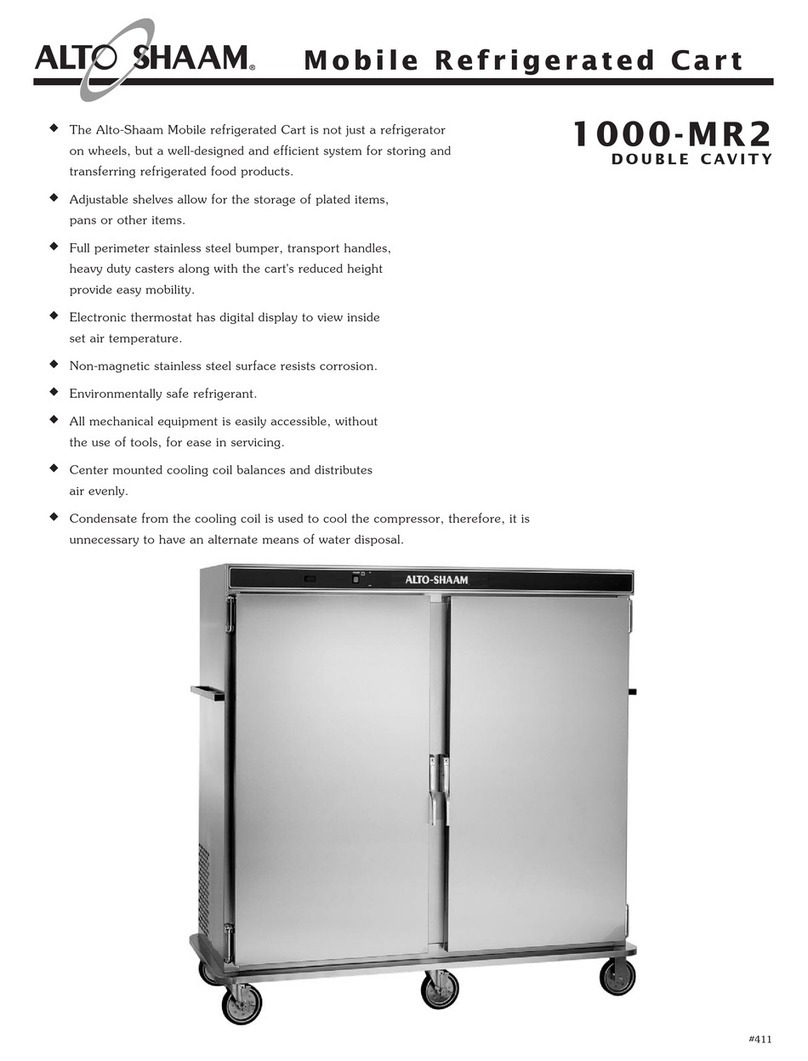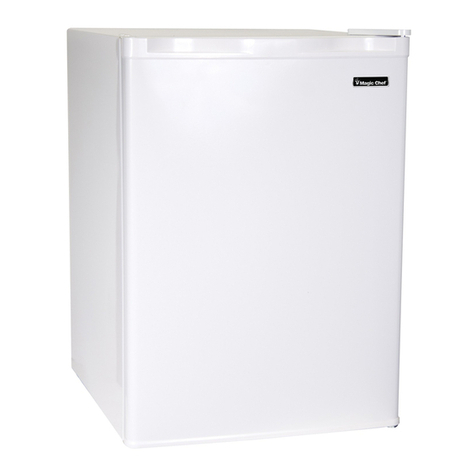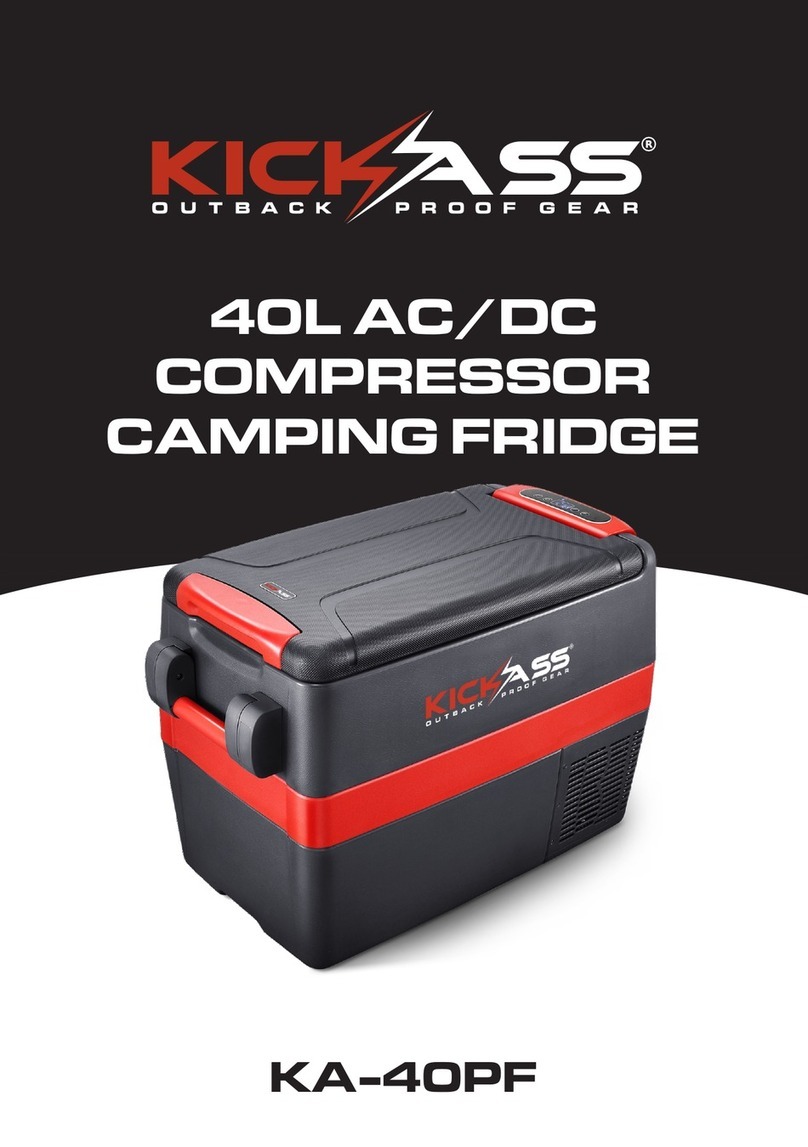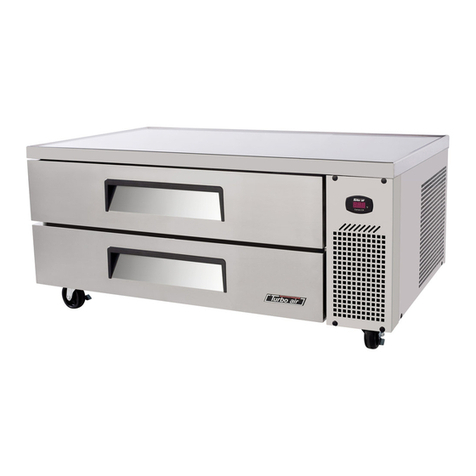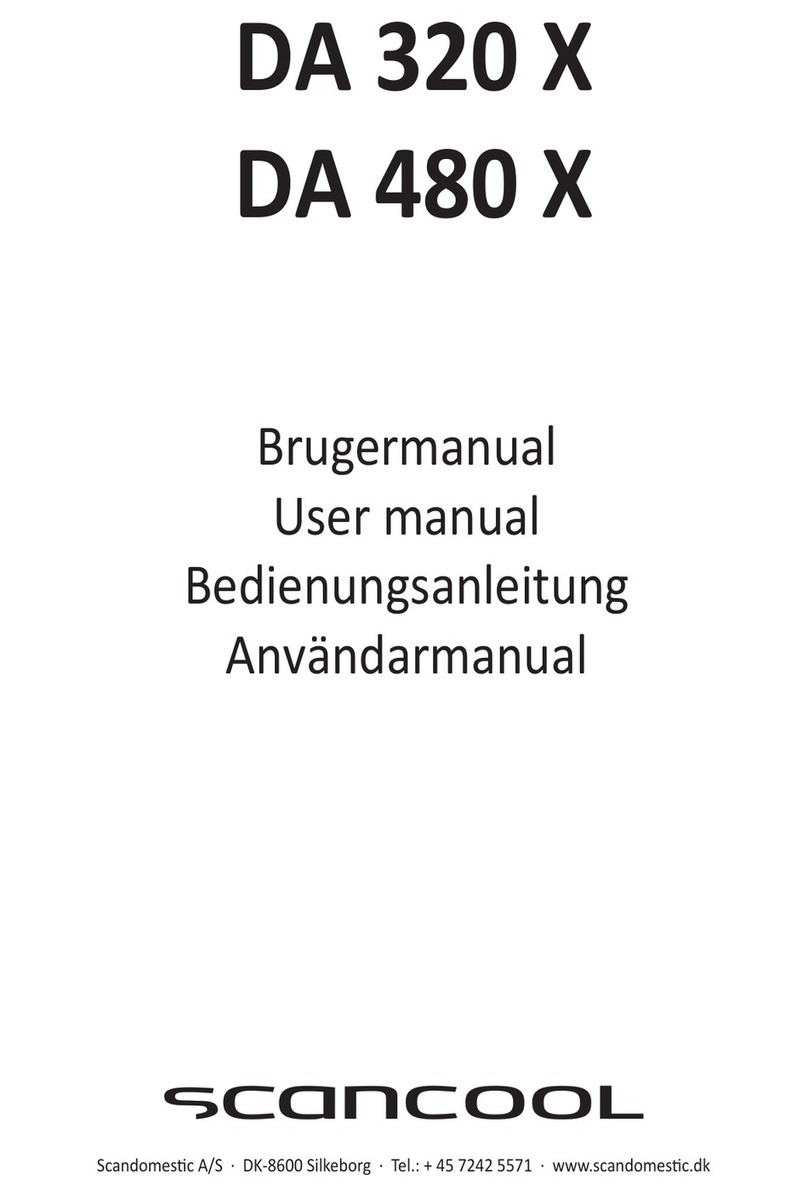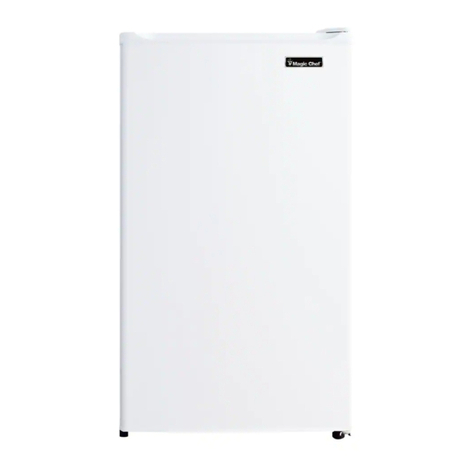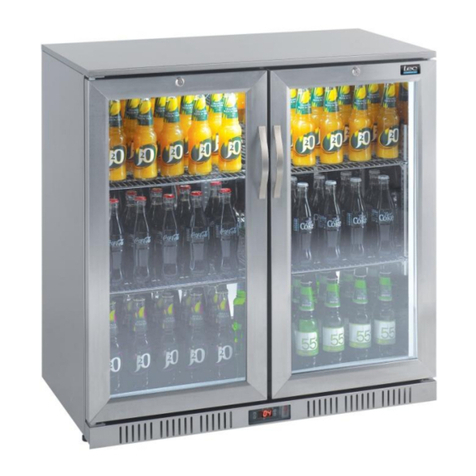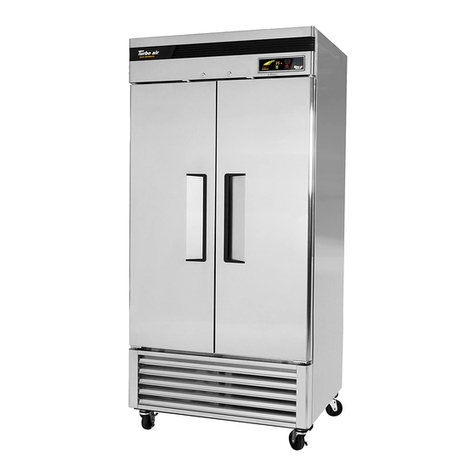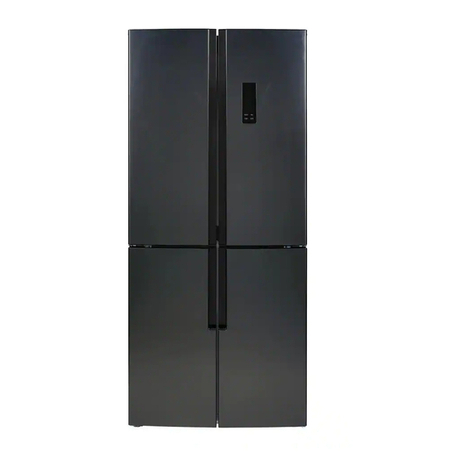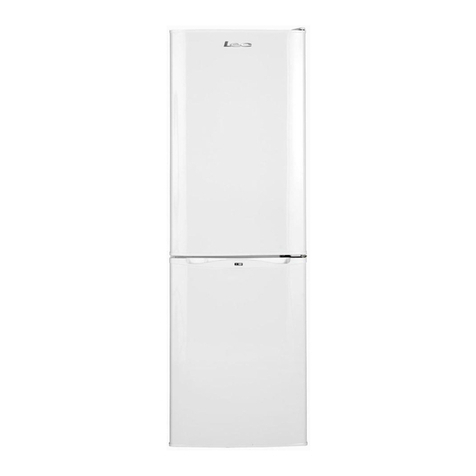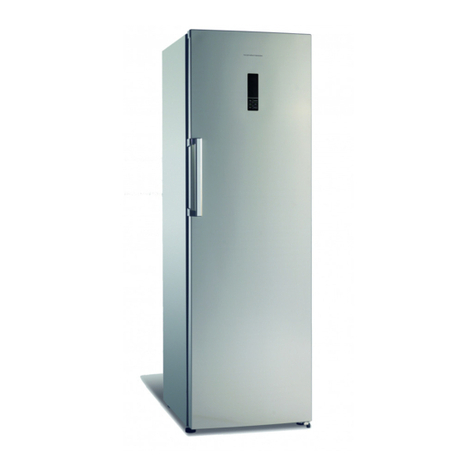bluefin ACTIVE XC-43G User manual

For use with BLUEFIN ACTIVE Absorption
Refrigerator. 12V – 230V – Gas
Model: XC-43G, FA50G, XC-62GAS, FA60G


Dear customer,
We are pleased that you have chosen a product from the BLUEFIN
ACTIVE range. BLUEFIN ACTIVE offers you the highest quality and
latest technology.
In order to take full advantage of the device‘s performance, and to
have many years of pleasure with your device, please read this manual
carefully before operation. The operational safety and function of
the device can only be guaranteed if the general safety and accident
prevention regulations of the legislator as well as the safety instructions
in this user manual are observed. We assume no liability for damages
caused by improper use or incorrect operation.
Please make sure that all persons using the device
have read and understood the user manual.

SAFETY PRECAUTIONS
This general safety information must be observed when using this
product. Read all instructions before using the product. Keep the user
manual in a safe place to be able to access it at any time if necessary.
Please keep this manual for future reference.
1. Before obtaining access to terminals, all supply circuits must be disconnected.
2. This appliance can be used by children aged from 8 years and above and persons
with reduced physical, sensory or mental capabilities or lack of experience and
knowledge if they have been given supervision or instruction concerning use of
the appliance in a safe way and understand the hazards involved.
However, children shall not play with the appliance. Cleaning and user
maintenance shall not be made by children without supervision.
3. This appliance is intended for use as a cool box using with three ways source
energy. The three ways are gas energy, AC electrical power and DC electrical
power. The three source energy can only be used separately.
4. If the supply cord is damaged, it must be replaced by the manufacturer, its service
agent or similarly qualified persons in order to avoid a hazard.
5. This appliance shall be installed according to the rules in force.
6. To be used only in a well ventilated area, above ground and protected from rain.
7. Precautions shall be taken to comply with national regulations relating to the
operation of gas appliances whilst the vehicle is in motion.
8. The precautions to be taken when changing the gas container which shall be
carried out away from any source of ignition.

SAFETY PRECAUTIONS (cont.)
9. Suitable for camping use.
10. The appliance may be connected to more than one source of energy.
11. Do not store explosive substances such as aerosol cans with a flammable
propellant in this appliance.
12. This appliance is intended to be used in household and similar applications such
as: staff kitchen areas in shops, offices and other working environments; farm
houses and by clients in hotels, motels and other residential type environments;
bed and breakfast type environments; catering and similar non-retail
applications.
13. For appliances have compartments to which access can be gained without the aid
of a tool and that are likely to be cleaned in normal use, the electrical connections
shall be arranged so that they are not subject to pulling during cleaning.
14. For technical reasons, this fridge is not suitable for use in boats. Whether you
operate the fridge on electrical power or gas, this fridge is not suitable for use in
boats.

INSTALLATION
This is a completely silent fridge. Therefore, do not
expect to hear any sound when you connect the
appliance to the power supply.
For technical reasons, this fridge is not suitable
for use in boats. Whether you operate the fridge on
electrical power or gas, this fridge is not suitable for
use in boats.
• Install the appliance levelled on a firm horizontal surface.
• The distance between the rear of the unit and the wall must be at
least 10 cm. The minimum distance to be observed on the sides
shall be at least 5 cm.
• Avoid placing the appliance in direct sunlight or near any source
of heat.
• Do not cover the ventilation openings at the top and/or at the back.
• Products which are to be stored in this fridge must be pre-cooled.
Never put hot products inside.
• Do not store flammable or explosive products.
• Always use plastic containers and bottles for storing products.
• Ensure there is a space around the contents for the circulation of
cold air.
• Complying with the above will ensure efficient and economical
cooling.

OPERATION USING THE MAINS: 230V/50HZ
1. Never use another source of energy at the same time (battery or gas).
2. Verify that the mains voltage corresponds to the operating voltage specified on
the technical data label at the back of the appliance. If the electrical specifications
are correct, plug the safety electrical connector into an earthed wall socket, which
should be wired according to the ruling regulations.
3. Turn the 230V thermostat knob (left) clockwise to the position “max”. After about
one hour, the effects of the cooling process become visible; frost on the inside
evaporator.
4. The thermostat enables the temperature of the fridge to be adjusted. After a
cooling period of about 5 hours, the thermostat can be set on a desired position;
this position is influenced by the surrounding temperature and the intensity
of use. Select a suitable position for the thermostat knob but do not put at the
minimum position as the cooling process will stop completely (i.e. no cooling). The
appliance can be switched off by removing the plug from the wall socket.

OPERATION USING A BATTERY (12V)
1. Never use another source of energy at the same time (mains or gas).
2. Prior to use of any battery; verify the voltage of the battery with the voltage
indicated on the technical data label at the back of the appliance.
3. When the appliance is powered by a car battery, only switch the fridge on while
the car is travelling. If the appliance remains switched on when the car’s engine
is not running, then the battery will be discharged and it may be impossible to
restart the engine.
4. When using a battery as a power source, there is no thermostatically temperature
controller (i.e. you cannot increase or decrease the temperature inside the fridge).
The cooling performance of the fridge using a 12V energy source would be as
follows: at 25~32° ambient, the inside temperature of the fridge would be around
18~22° below ambient.
5. Pre-cool the fridge using the mains before starting a journey and try to put only
pre-cooled products inside the fridge.
6. To start up the unit, connect the supplied cable at the back in the 12v socket
and put the corresponding side into the cigar lighter socket of the vehicle. To
disconnect, remove the connector from the cigar lighter socket.

OPERATION USING BOTTLE GAS
1. Never use another source of energy at the same time (mains or battery).
2. Operation on gas is prohibited in small closed areas, in small vehicles and in
boats. When using the appliance in caravans and mobile homes, a well and sound
ventilation should be provided. Vents in the wall facing the back of the fridge
have to be provided with all other flu pipes etc to ensure sound ventilation. All
works MUST be done by an experienced fitter. In all cases the location should be
protected from rain and/or splashing.
3. The fridge doesn’t come with a flue kit, but a flue bend is provided which can be
fitted at the top of the exhaust outlet on the back of the fridge. This flue bend is to
assist in fitting any other parts of a suitable flue kit. All works for the fitting of a
flue kit should be done by an experienced fitter.
4. The gas cylinder must be stored in a cool, dry, ventilated area and never
in a basement or a cellar. Protect from sunlight and do not expose to high
temperatures.
5. The appliance cannot operate at a pressure other than the one specified on the
identification label at the back. It is recommended to use an appropriate pressure
regulator.
6. During connection of the fridge to the gas cylinder, always stay clear of any sort of
ignition and do not smoke. Connect in the order: gas cylinder – pressure regulator
– appliance. Excessive twisting and bending of the flexible hose must be avoided.
Check for leaks should be done only by means of soapy water. Never check for
leaks using a flame. When changing the gas cylinder or disconnecting the hose,
it is necessary to close the valve of the gas cylinder. Always replace a damaged or
porous hose.
7. The gas valve knob (right) is a combination of gas control and ignition.
Furthermore the gas valve assembly consists of an incorporated safety pilot, a
burner with an ignition plug and a piezo igniter. The safety pilot automatically
maintains the gas supply as long as it remains lit. It automatically shuts off the
supply of gas if the flame goes out.

OPERATION USING BOTTLE GAS (cont.)
8. Open the gas valve of the gas cylinder; press the gas valve knob in the panel, wait
approximately 15 seconds, turn the pressed knob in the direction of the arrow,
a click of the igniter can be heard and the gas flame is ignited. Hold the knob
pressed in this position so that the flame remains burning. It might be possible
that this operation has to be repeated a couple of times, especially if the appliance
has not been used for a long time or if the gas cylinder has been changed. There
can be an air in the system, which has to be forced out. It is necessary to check
that the pilot is lit by looking through the orifice at the top of the unit or through
the hole at the back near the burner. If the flame fails to light, wait at least a
minute before trying again.
9. To disconnect the fridge running on gas: close the valve of the gas cylinder and
then turn the gas valve knob in the panel to position ‘press’.
10. When using the gas as a power source, there is no thermostatically temperature
controller (i.e. you cannot increase or decrease the temperature inside the fridge).
The cooling performance of the fridge using gas energy source would be as
follows: at 25~32° ambient, the inside temperature of the fridge would be around
18~22° below ambient.

MAINTENANCE & STORAGE
The fridge must be defrosted regularly in order to ensure a correct operation. To
defrost the appliance, disconnect it, empty it and if necessary use a cloth with hot
water. Dry and clean the inside without using abrasive products. Never use a knife or
other sharp tool to remove ice. If the appliance is to remain unused for a longer period,
disconnect it, clean it and leave the fridge door slightly open during storage to prevent
unpleasant odours. Put some talcum powder in the gasket of the lid. If after such a
period the refrigerator does not cool when operating, switch it off again and leave it
turned upside down for few hours. Put it the right way up and connect again.
All repairs, if needed, particularly of the cooling unit or the gas burner system, can
only be carried out by a qualified technician.
If a problem occurs, first carry out the following checks:
• Are all accessories and sources of energy correct?
• Are the various connections correct?
• Is the appliance installed in a horizontal position? Is there sufficient ventilation?
• Is the mains supply correct in case of using 230V? Is the 12v battery sufficiently
charged?
• Is the gas cylinder sufficiently filled?
• Has the gas valve knob been pressed long enough?
• Has the thermostat knob been set to a higher and adequate position? . Have 2
modes of operation been selected by mistake at the same time? Is there too much
food inside the appliance?
• Is there sufficient circulation of cold air inside the appliance?

TECHNICAL DATA
Item No.
Net capacity
Refrigerant
AC supply
DC supply
Climate class
Isolation
Gas category
Gas type
Gas pressure
Heat input
Gas consumption
Destination country
Gas cylinder
Gas hose
Gas regulator
This appliance belongs to type A11
Read manufacturer’s instructions before use - this appliance shall be installed
according to the rules in force.
To be used only in well-ventilated area, above ground and protected from rain.
XC-43G, FA50G
43L
Ammonia- NH3, 85g
230V/50Hz, 90W, 0.39A
12V, 90W, 7.5A
N, SN
Cyclopentane
I3+(28~30/ 37) I3B/P(30) I3B/P(37) I3B/P(50)
G30 (Butane), G31 G30 (Butane), G31 (Propane) and their
(Propane) mixtures
G30 (Butane) at 28-30 mbar 37 mbar 50 mbar
(28-30) mbar / G31
(Propane) at 37
mbar
150W 180W 180W
11 g/h 13 g/h 13 g/h
BE, FR, IT, LU, IE, LU, NL, DK, FI, PL DE, AT,
GB, PT, ES, CY, CZ SE, CY, CZ, EE CH, LU,
LT, SK, CH, SI, LV LT, MT, SK, SI, SK
BG, IS, NO, TR,
HR, RO, IT, HU
LV
Standard gas cylinder with maximum weight not exceeding
15 kg (Maximum Dia. 320mm, Maximum height 550mm /
below the gas connection). The cylinder shall comply with
local code. The cylinder should be firmly fixed. Do not use
or store near flammable or explosive products.
Certified gas hose according to applicable EN-standard and
comply with local code (max 1.5m / 1.2m in Finland).
NB/ It is necessary to change the hose when national
conditions require it.
Certified regulator according to EN 12864

TECHNICAL DATA (cont.)
Item No.
Net capacity
Refrigerant
AC supply
DC supply
Climate class
Isolation
Gas category
Gas type
Gas pressure
Heat input
Gas consumption
Destination country
Gas cylinder
Gas hose
Gas regulator
This appliance belongs to type A11
Read manufacturer’s instructions before use - this appliance shall be installed
according to the rules in force.
To be used only in well-ventilated area, above ground and protected from rain.
XC-62GAS, FA60G
60L
Ammonia- NH3, 125g
230V/50Hz, 100W, 0.43A
12V, 100W, 8.33A
N, SN
Cyclopentane
I3+(28~30/ 37) I3B/P(30) I3B/P(37) I3B/P(50)
G30 (Butane), G31 G30 (Butane), G31 (Propane) and their
(Propane) mixtures
G30 (Butane) at 28-30 mbar 37 mbar 50 mbar
(28-30) mbar / G31
(Propane) at 37
mbar
180W 200W
13 g/h 14.6 g/h
BE, FR, IT, LU, IE, LU, NL, DK, FI, PL DE, AT,
GB, PT, ES, CY, CZ SE, CY, CZ, EE CH, LU,
LT, SK, CH, SI, LV LT, MT, SK, SI, SK
BG, IS, NO, TR,
HR, RO, IT, HU
LV
Standard gas cylinder with maximum weight not exceeding
15 kg (Maximum Dia. 320mm, Maximum height 550mm /
below the gas connection). The cylinder shall comply with
local code. The cylinder should be firmly fixed. Do not use
or store near flammable or explosive products.
Certified gas hose according to applicable EN-standard and
comply with local code (max 1.5m / 1.2m in Finland).
NB/ It is necessary to change the hose when national
conditions require it.
Certified regulator according to EN 12864

DIAGRAM OF PARTS
1. Door
2. Gasket Lid
3. Door Shelf
4. Hinge, lower right
5. Shelf
6. Shelf
7. Hinge, lower left
8. Removable drip tray
9. Cooling flange
10. DC 12V switch
11. AC 230V switch
12. Rotary knob thermostat
13. Rotary knob gas
14. Indicator
15. Front decoration
16. Hinge right

This symbol on the product or on its packaging indicates that this product must not
be disposed of with your other household waste. Instead, it is your responsibility to
dispose of your waste equipment by handing it over to a designated collection point for
the recycling of waste electrical and electronic equipment. The separate collection and
recycling of your waste equipment at the time of disposal will help to conserve natural
resources and ensure that it is recycled in a manner that protects human health and
the environment. For more information about where you can drop off your waste
equipment for recycling, please contact your local city office, your household waste
disposal service or the shop where you purchased the product.
Bluefin Trading Ltd, Wadsworth, Hebden Bridge, W. Yorks, UK, HX7 8TG
1. Top cover
2. Control panel
3. Door
4. Door Shelf
5. Shelf
6. Casing

support@bluefintrading.co.uk
www.bluefinactive.com
This manual suits for next models
3
Table of contents
